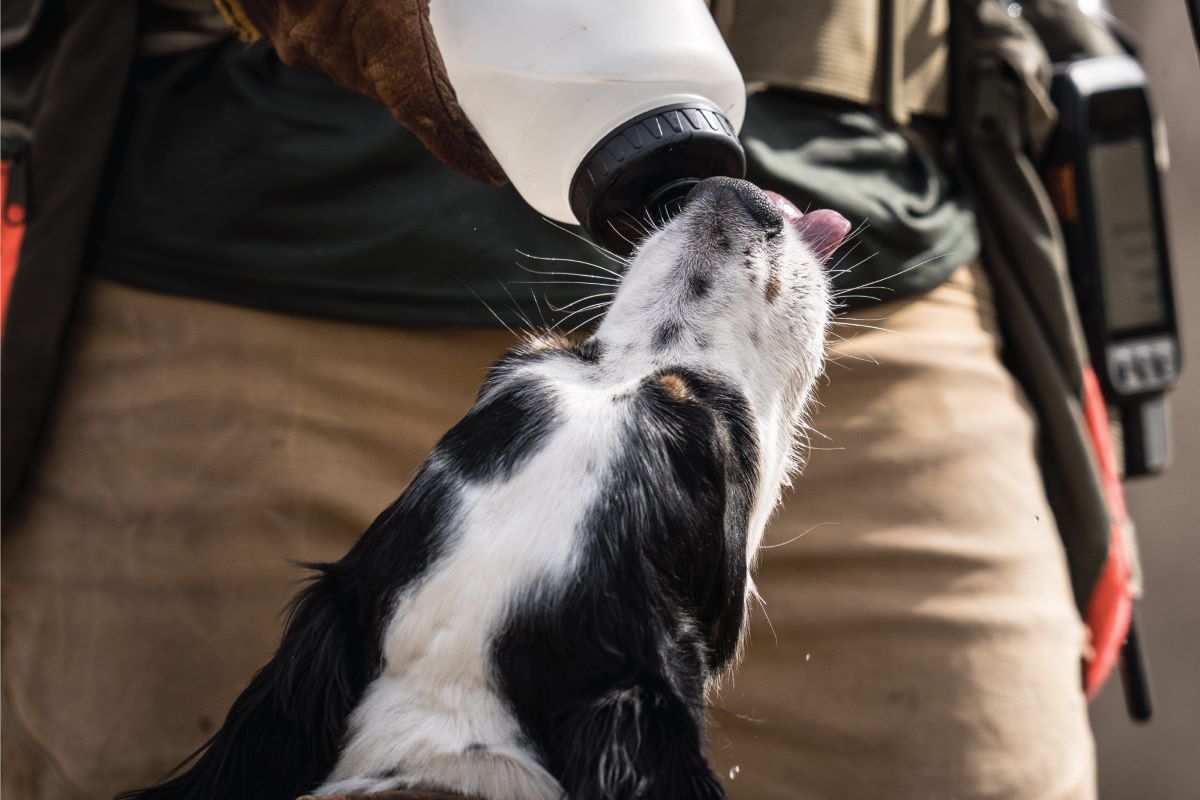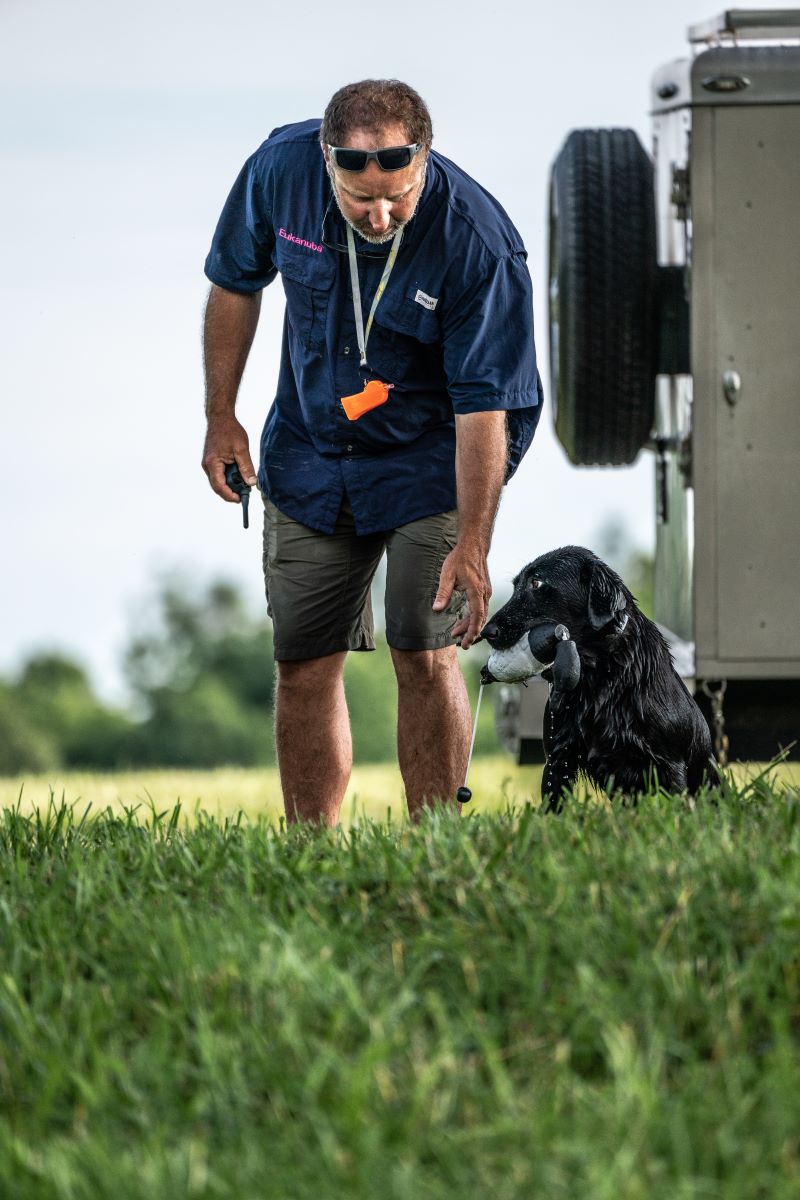SPONSORED CONTENT: EUKANUBA
There’s only one way to get your gundog ready for hunting season, and that’s to condition when it’s hot. Conditioning is progressive, and it’s best if it starts in the spring. Still, summer training includes high heat and humidity, which can be a dangerous combination. Here are some ways to get started so that you and your string safely get to Opening Day.
How Much for How Much? If you’ve been running field trials or hunt tests since the end of the hunting season, then your dog probably is in great shape. But if your string has been sedentary, then you’ve got some pre-conditioning work to do.

- Office Hours - Start with a vet visit. An annual appointment is the perfect time to make sure your dog has a clean bill of health. Update regular vaccinations, check weights, and review general health.
- Energy to Go Hard All Day - Many handlers change foods at the end of hunting season. Dogs that aren’t working hard don’t need the extra energy. If you’ve dropped from Eukanuba’s Premium Performance Sport 30/20 to Exercise 26/16, then you’ll need to transition back so your dog has enough energy and nutrients to handle the extra workload. Evaluate his body-condition score, review his activity level, and establish his daily caloric needs. Here’s a helpful article on how to feed your sporting dog. Energy comes from carbohydrates, protein, and fat. Carbohydrates burn quickly, so they’re the ideal power source for dogs working intensely for short periods of time. Dogs running for up to two hours at a time get their energy from fat. And dogs running up to four hours at a time need even more energy. Match your dog’s work with the appropriate nutrition.
- Slow and Steady Wins the Race - Roading starts as a slow grind. Fifteen minutes at a slow pace every other day is enough, even if your dogs are pulling on the roading harness and want to go faster. Keep speeds slow until their bodies adjust. After two weeks you’ll see their fitness levels improve and you can start to increase. Gradually add time and intensity. For instance, week three could be slightly longer in time and at a slightly faster pace every other day. In week four, raise the bar to a level that your dogs can handle. Take into consideration that all dogs handle conditioning differently.
- Get Creative - If you don’t have roading gear or open space, then get your dogs in shape with canicross or bikejoring. After hunting season ends you can keep them in shape throughout the winter months, too. Year-round dog fitness is an excellent goal.
- Watch for Heat Related Illness (HRI) - There are two types of heat-related illnesses: exertional and non-exertional. Exertional HRI comes when you’re working dogs when it’s hot and humid. Non-exertional HRI can occur if a dog is left in a car in the summer with the windows rolled up. Dogs may suffer from one of the three stages of HRI: heat stress, heat exhaustion, and heat stroke. Eukanuba has championed awareness of HRI for years, so learn to identify the symptoms and actions to help keep your dog safe.
- Drinks Are on the House - How much water should your sporting dog drink during preseason training? According to Dr. Jill Cline, Professional and Veterinary Engagement Manager for Eukanuba and Royal Canin, “Daily water losses for a 44-pound dog can range from 0.5 to 1.5 U.S. gallons, depending upon activity and environmental setting.1” Make sure your dog is drinking enough water each day, and increase the amount if he’s working hard. The amount will vary by dog, as the hydration needs of a pointer running in hot Montana fields is different from a Labrador retriever working in marshes and rivers.

Pro trainers have to work through the heat, and here’s some advice that comes from many decades of experience.
Al Arthur of Georgia’s Sandhill Retrievers is the two-time winner of the U.S. National Open Retriever Championship. The Eukanuba pro trainer says, “Heat’s a tough thing. Not all dogs handle the heat the same way, and some have higher tolerances than others.”
- Plan your work, then work your plan. “I’ll run two to three setups in the early morning for each dog. The difference in the summer is that I’ll shorten the distances so the dogs get regular work at a high, focused level that won’t negatively impact their recovery.”
- Cut water. “While running their setups, I always make dogs cut water. The pond temperatures are the coolest they’ll be during the day, and that regular splash and swim cools them down while running. Keeping them cool while running helps them work through their entire setup in a focused manner.”
- Easy breezy. “Just as you’ll cut water on a setup, switch from cover to open space. When the dogs hit the open space, they’ll get more breeze, and the breeze cools them off while running.”
- Head to cooler climates. “Competing is my job. When it warms up too much in Georgia, I’ll train up north from July through September. I still am careful, because in the summer it’s hot and humid pretty much everywhere.”
- Read your dog. “When a dog is sucking air, he is focused on cooling down. He’s not paying attention to the training correction I’m trying to make. If a dog shows signs of overheating, pick him up and cool him down. Tomorrow’s another training day, but you won’t get to it with an injured dog.”

South Carolina’s Mark Fulmer also knows about the summer heat. The owner of Sarahsetter Kennel and Eukanuba pro trainer deals with regular summer temperatures over 100° F. “I don’t run dogs before sunrise like a lot of trainers do,” he said. “In the early dawn the air is still, and there is both high humidity and high temperatures. I wait until 9 a.m., because that’s when the breezes kick in. Once the air is moving, I’ll think about the kind of work I need to do for my clients’ dogs.

“I condition dogs by free-running them in a fenced-in four-acre pasture. About 20 years ago I added a pool in my training area. It’s 10 feet in diameter and three feet deep. When the dogs get hot from running, they jump in to cool off. I fill the pool every other day, so it’s always cool but not cold. “I’ll use the pool for working on water retrieves, too. All of my setters make water retrieves. Most of the hard running and roading is from October through March when it’s much cooler than in the South Carolina summer. If it’s too hot to run, then I’ll focus on less-intense activities. Steadiness work is never done, so I’ll stack dogs on a whoa table and throw pigeons. I’ll also do some 10- to 15-minute setups where the dogs will get a few bird contacts. I’ll mix it up with some basic obedience, too.”
Getting dogs ready for hunting season is fun. Take it slow and make it steady, and you and your dogs will be in great shape for the best time of the year.
1 REYNOLDS, AJ, K SNEDDEN, GA REINHART, KW HINCHCLIFF, AND RA SWENSON. 1998. HYDRATION STRATEGIES IN EXERCISING DOGS. IN: GA REINHART AND DP CAREY EDS. RECENT ADVANCEMENTS IN CANINE AND FELINE NUTRITION, VOL. 2, IAMS NUTRITIONAL SYMPOSIUM PROCEEDINGS. ORANGE FRAZER PRESS, OH, PP 259-267




